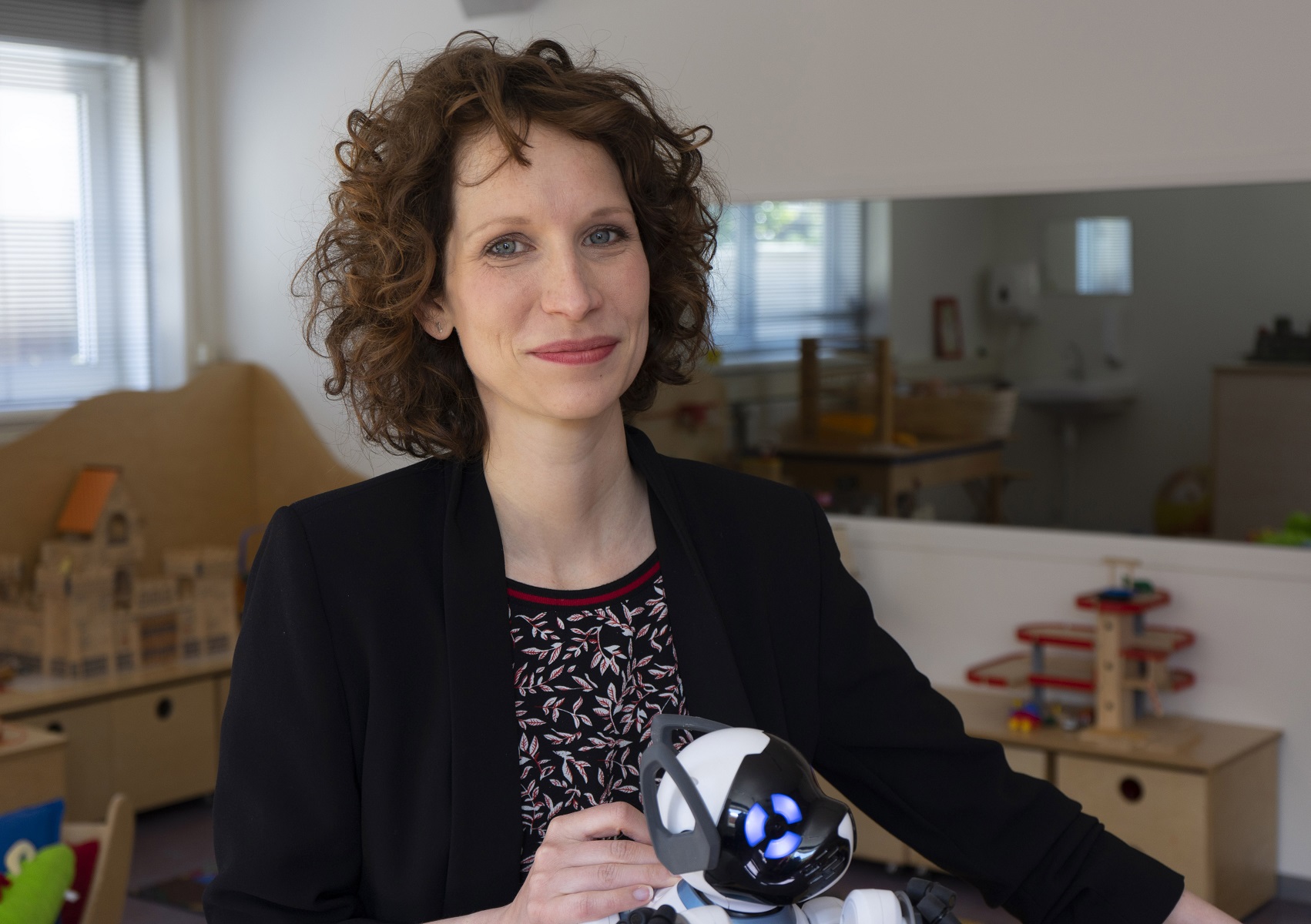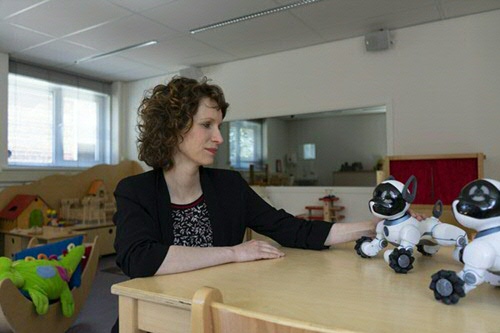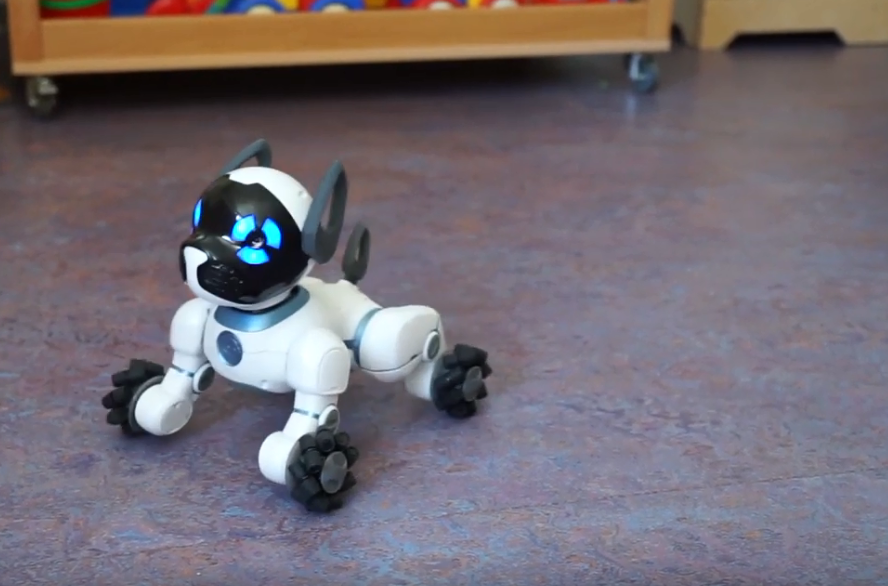Een therapeut op vier poten

‘Knuffelsessies’ met kittens tegen stress, dieren in verzorgingstehuizen als middel tegen eenzaamheid, voorleesprojecten met honden, zorgboerderijen – de inzet van dieren in de zorg is booming. En met positief resultaat, zo blijkt uit de praktijk. Maar de theoretische onderbouwing blijft nog achter, stelt Steffie van der Steen, RUG-onderzoeker bij de afdeling Pedagogische en Onderwijswetenschappen. Ze staat aan de start van een groot driejarig project, waarmee ze hoopt de theorie aan de praktijk te verbinden.
Tekst: Nynke Broersma / Foto's: Merel Weijer
Om meteen een vooroordeel de wereld uit te helpen: Van der Steen heeft zelf geen huis vol dieren. ‘Die vraag krijg ik heel vaak, ja! Maar het is eerder het tegenovergestelde: juist door mijn werk ben ik veel gaan nadenken over dierenbelangen. Een hond heeft veel tijd en aandacht nodig en dat lukt nu niet’, reageert ze nuchter. Dat ze uiteindelijk bij diertherapie terecht is gekomen heeft dan ook meer te maken met haar specialisme in de Orthopedagogiek dan met een passie voor dieren. ‘Dit vakgebied was een kans die op mijn pad kwam. En ik vind het heel leuk om gewoon ergens in te springen en me er dan helemaal op te storten.’

Hond bij de psychiater
Van puppy’s knuffelen tot voorleesprojecten, er zijn genoeg voorbeelden te vinden waarbij dieren worden ingezet om het welzijn van mensen te verbeteren. Ze zijn allemaal te scharen onder ‘dier-ondersteunde interventies’, een onderzoeksveld dat volgens Van der Steen sterk aan het groeien is en in beweging is. Maar compleet nieuw is het niet. Eerder onderzoek heeft aangetoond dat contact met dieren een positief effect kan hebben. Zo komt het ‘knuffelhormoon’ oxytocine vrij. Dieren kunnen er ook voor zorgen dat je je aandacht verplaatst. Dat maakt moeilijke dingen makkelijker bespreekbaar. ‘Een van de eerste mensen die onderzoek deed naar dier-ondersteunde interventies was een psychiater. Toen hij toevallig zijn hond meenam naar het werk merkte hij dat mensen makkelijker praatten’, vertelt Van der Steen.
Afstemming
Diertherapie is een vorm van dier-ondersteunde interventies, met over het algemeen iets strengere criteria. Zo wordt het uitgevoerd door een geschoolde professional op het gebied van sociaal welzijn. Ook worden er behandeldoelen opgesteld en vindt er evaluatie plaats. Het is een vorm die steeds vaker wordt ingezet in de zorg, bijvoorbeeld bij kinderen met Downsyndroom of Autisme. Uit praktijkonderzoek komen daarbij positieve effecten naar voren, maar de wetenschappelijke onderbouwing blijft soms nog achter. ‘Zo zijn er grote verschillen in de manier waarop de onderzoeken worden opgezet en in de rol die dieren spelen. Bovendien wordt het effect over het algemeen alleen gemeten tijdens de sessies of vlak daarna, en is er weinig aandacht voor de blijvende effecten in het dagelijks leven’, zegt Van der Steen.
Daarom draait Van der Steen het om: ze begint bij een theorie, en gaat die vervolgens toetsen. Van der Steen denkt dat ‘afstemming’ weleens de sleutel zou kunnen zijn. In de ontwikkelingspsychologie wordt dat ook wel synchrony of interpersonal coordination genoemd. ‘Een goede afstemming zorgt ervoor dat het contact met anderen soepel verloopt. Bijvoorbeeld in gesprekken, waarbij je om de beurt het woord neemt. En bij de afwisseling tussen leiden en volgen. Een ander mooi voorbeeld is het ongemakkelijke moment dat je een tegenligger treft op de stoep, en je samen moet besluiten welke kant je uitgaat om een botsing te vermijden. Afstemming is dus een groot onderdeel van het dagelijks leven. Maar kinderen met Autisme of Downsyndroom kunnen hier soms moeite mee hebben.’

Honden oordelen niet
Om te onderzoeken of afstemming inderdaad een rol speelt bij de werking van diertherapie, volgen kinderen die deelnemen aan Van der Steens onderzoek therapiesessies met een hond. Tijdens de sessies moeten ze de bijvoorbeeld samen met de hond een simpel parcours afleggen en geven ze commando’s die de hond moet volgen. Een geval van ‘oefening baart kunst’: als kinderen met Autisme of Downsyndroom kunnen oefenen met afstemmen in een veilige omgeving, kunnen ze dit in sociale situaties met andere mensen mogelijk ook makkelijker doen.
Maar waarom is dit niet te oefenen met mensen? ‘Honden oordelen niet, althans niet zichtbaar. En ze hebben geen bijbedoelingen. Dat maakt het minder spannend voor cliënten’, zegt Van der Steen. ‘Tegelijkertijd zijn honden, net als mensen, niet compleet voorspelbaar. Met een dier moet je dus ook goed afstemmen om het contact soepel te laten verlopen. In het pilotonderzoek zagen we hier een mooi voorbeeld van. Een hond was afgeleid en week daarom af van het parcours. De deelnemer aan het onderzoek moest de aandacht zien terug te pakken. Dat deed hij uiteindelijk door lager stemgebruik. Zo kreeg hij de hond toch zover.’
Roedel van robothonden
Een deel van de kinderen uit het onderzoek volgt geen sessies met echte honden, maar met robothonden. Van der Steen heeft dan ook een heuse roedel in haar kantoor. Ze heeft ze allemaal persoonlijk een naam gegeven. Niet uit sentimentaliteit, maar omdat ze anders niet reageren op commando’s. ‘Max, sit down!’, demonstreert ze, en een van de robothonden gehoorzaamt braaf. ‘Dat was vanmiddag wel anders. Ik gaf een presentatie over het onderzoek en er waren technische problemen. Ik heb ‘m uiteindelijk maar uitgezet om het later opnieuw te proberen. Maar in het echte leven gaat dat niet. Denk aan de tegenligger: als de afstemming lastig verloopt kun je moeilijk zeggen: “Zullen we weer even naar het begin van de straat gaan en opnieuw beginnen?” De afstemming met een robothond is dus veel eenzijdiger dan die met een echte hond of met een mens. De robothond zal daarom naar verwachting minder positief effect hebben op de sociale vaardigheden van kinderen in het dagelijks leven.’
Artikel loopt door onder video

Deelnemers gezocht
Waar bij eerdere onderzoeken vooral het effect van diertherapie tijdens de therapiesessies is gemeten, zal de ‘follow-up’ bij Van der Steens onderzoek ook heel belangrijk zijn. Ze kijkt niet alleen naar het effect tijdens of vlak na de sessies, maar ook drie maanden later. Want als kinderen met Autisme of Downsyndroom beter leren afstemmen met honden, is het nog maar de vraag of ze die vertaalslag ook kunnen maken naar het echte leven. Zullen ze ook beter kunnen afstemmen met hun ouders/verzorgers of vriendjes en vriendinnetjes? Het antwoord laat nog even op zich wachten. Voor nu is Van der Steen voornamelijk nog bezig met het vinden van kinderen die willen deelnemen en therapeuten. En als blijkt dat afstemming geen rol speelt? ‘Dan is dat een verrassend resultaat, en daar hou ik wel van!
Meer informatie
- Luister ook naar de RUG-podcast met Steffie van der Steen
- Steffie van der Steen
Meer nieuws
-
08 december 2025
Burgerparticipatie onmisbaar voor een duurzame energietoekomst
-
23 oktober 2025
Negen wetenschappers van de RUG ontvangen Vidi-beurs
